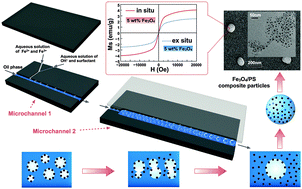In situ dispersion of non-aqueous Fe3O4 nanocolloids by microdroplet coalescence and their use in the preparation of magnetic composite particles†
Abstract
Monodispersity and size uniformity are critical issues for nanoparticles, especially for the inorganic particles dispersed in organic carriers serving as the precursor of composites. Herein, for the first time, we have developed a method based on flow-induced droplet coalescence for in situ dispersion of surface-modified Fe3O4 nanoparticles to prepare Fe3O4/polystyrene (Fe3O4/PS) composite particles. A plate-type microchannel was constructed to initiate droplet coalescence for reducing the water–oil interfacial area and for dispersing Fe3O4 nanoparticles into the precursor suspensions. Under optimized conditions, the precursor suspensions could be composed of monodispersed Fe3O4 nanoparticles with an average size of approximately 12 nm. In this case, the saturation magnetization of the prepared superparamagnetic composites was as high as 4.012 emu g−1 at a magnetite content of 5 wt%. The method is simple and has great potential to be tailored for the preparation of non-aqueous suspensions with uniform and monodispersed nanoparticles.


 Please wait while we load your content...
Please wait while we load your content...